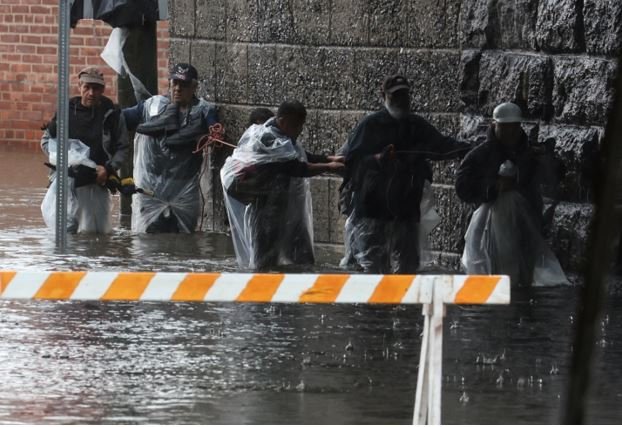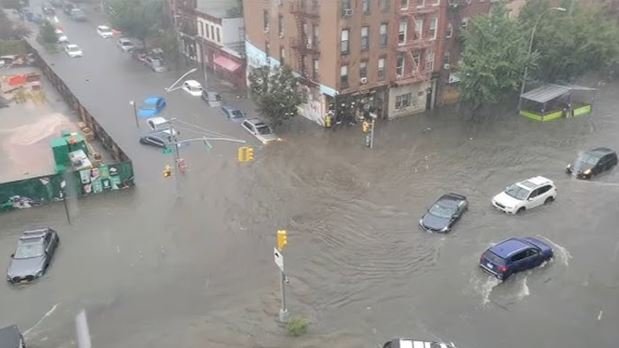New York City still found itself ill-prepared for impending storms. This vulnerability was further exacerbated by the city’s aging infrastructure, underscoring the urgent need for comprehensive climate resilience measures
New York City has found itself in a state of emergency as relentless storms have unleashed flash flooding throughout the metropolis. The deluge has inundated a significant portion of the city, submerging its subway system, streets, and highways. At one point, LaGuardia Airport had to shut down one of its terminals temporarily before resuming operations later. Some areas within the city experienced a staggering 8 inches (20 cm) of rainfall, although the skies began to calm by evening.
Governor Cathy Hochul did not mince words, describing the situation as a perilous and life-threatening storm. She officially declared a state of emergency encompassing New York City, Long Island, and the Hudson Valley, owing to the unprecedented downpour sweeping across the region. Via her social media platform of choice, X (formerly known as Twitter), Governor Hochul urged residents to prioritize safety and avoid any attempt to traverse waterlogged roads. Fortunately, there were no reported fatalities or serious injuries.
You can also read: “Systemic racism pervades US police and justice systems”: UN Human Rights Council
Across the Hudson River in Hoboken, New Jersey, a state of emergency was also declared in response to the same weather chaos that New York City was facing. Mayor Eric Adams sounded the alarm within the city, stressing the need for heightened vigilance and extreme caution. He noted the severe disruptions to daily life, especially the subway system, and the city’s challenges in navigating the situation.
The Metropolitan Transportation Agency confirmed that the flooding had inflicted significant disruptions to New York’s subway network and Metro North commuter rail service. Some subway lines were entirely suspended, and numerous stations had to be shut down. In Mamarnake, a suburb north of New York City in Westchester County, emergency teams resorted to inflatable rafts to rescue individuals trapped in flooded buildings, as reported by Reuters.

In the span of just an hour, more than 2.5 inches of rain poured down upon the Brooklyn Navy Yard, surpassing the capacity of New York City’s sewage system, designed to handle only 1.75 inches per hour. New York’s chief climate officer, Rohit Agarwala, emphasized that it was unsurprising that parts of Brooklyn experienced such severe consequences given this disparity.
Fleeing Rising Floodwaters in New York City
In the heart of South Williamsburg, Brooklyn determined workers navigated knee-high floodwaters, their primary mission being to unclog a drain obstructed by debris, including cardboard. Among those affected, Kelly Hayes, a local resident, estimated that the extensive flood damage inflicted on her bar and kitchen in the Gowanus neighborhood would tally a daunting $25,000 to $30,000 (£20,500-$24,500) in repair costs.
The deluge’s impact extended to La Guardia Airport, where Terminal A was forced to shut down due to the flooding, as confirmed by authorities. Travelers were advised to reach out to their respective airlines before embarking on their journeys.
The New York Police Department took decisive action by announcing the closure of several roadways across the city. Simultaneously, the National Guard was called upon to provide critical assistance and support in the areas severely affected by flooding.
On Manhattan’s eastern flank, a prominent section of the FDR Drive, a vital thoroughfare, witnessed water levels rising above car tires. This inundation brought traffic on this major route to an abrupt standstill.
In a historic turn of events, New York City found itself grappling with a relentless downpour, accumulating a staggering 14 inches of rain throughout the month. This meteorological anomaly has catapulted September into the annals of history as the wettest the city has experienced since 1882, as documented by the National Weather Service.
Climate Change and New York City
New York City once again finds itself grappling with the repercussions of extreme weather as historic rainfall inundates the metropolis. This event occurs a mere two years after the remnants of Hurricane Ida unleashed devastating flooding across all five boroughs, resulting in the loss of at least 13 lives. These recurring crises lay bare the vulnerability of the Big Apple’s aging infrastructure in the face of climate change-induced extreme weather events. More than a decade has passed since Hurricane Sandy compelled city officials to reevaluate their approach to climate resilience, and it is evident that substantial work remains.
Joseph Kane, a fellow specializing in infrastructure at the nonprofit think tank Brookings Institute, underscored the undeniable reality confronting city leaders, particularly in places like New York. He emphasized that the climate has become more extreme and unpredictable, necessitating increased investments in infrastructure. Regrettably, such action is often initiated when it is already too late to prevent significant damage.

Steve Bowen, the Chief Science Officer at global reinsurance broker Gallagher Re, pointed out that these extreme weather events are serving as stark reminders of the rapidly shifting risks faced by cities like New York due to climate change. Increased rainfall intensity, combined with the deteriorating state of existing infrastructure, paints a concerning picture for the city’s ability to adapt and withstand the challenges posed by a changing climate.
Impact of a Warmer Atmosphere on Storm Intensity
One of the key factors at play in these increasingly intense storms is the capacity of a warmer atmosphere to hold and distribute more moisture, according to Steve Bowen. This phenomenon results in the amplification of storm intensity.
Steve Bowen also emphasized the pressing issue of inadequate infrastructure not only in New York but also across the United States and globally. Current infrastructure is ill-equipped to withstand the climate conditions witnessed today, let alone those that lie ahead as the climate continues to change.
Zachary Iscol, the Emergency Management Commissioner of New York City, noted that the deluge experienced on that Friday marked the city’s wettest day since Hurricane Ida.
The devastating impact of Hurricane Sandy in October 2012 served as a pivotal moment for New York officials, awakening them to the gravity of climate and weather-related risks. The storm, which made landfall near Atlantic City, generated a catastrophic storm surge along the New York and New Jersey coastlines. It left 2 million New Yorkers without power, claimed the lives of 43 city residents, and damaged or destroyed around 70,000 housing units. The financial toll on New York City was an estimated $19 billion.
Insufficient Preparedness for Climate Risks
Despite these harrowing experiences, New York City has not made adequate strides in fortifying itself against future climate-related threats. Louise Yeung, the Chief Climate Officer of the Comptroller’s Office, revealed in April 2022 that nearly a decade after Superstorm Sandy and Hurricane Ida, the city remained unprepared for impending storms. The city’s aging infrastructure compounds this vulnerability.
A report from the Comptroller’s Office disclosed that New York City had only expended 73% of the $15 billion in federal grants awarded to the city through June 2022, which were intended for post-Hurricane Sandy initiatives. Moreover, a significant portion of the city’s own capital contributions for resilience projects remained unused. While progress has been made, it still falls short of what’s necessary.
Shifting Climate Challenges
Flash-flood events and Hurricane Ida have introduced new concerns. Many of the city’s investments following Hurricane Sandy primarily targeted coastal flooding and sea level rise, overlooking the escalating risk of extreme rainfall. Louise Yeung highlighted that heavy rainfall is becoming the new norm as climate change intensifies. To address this, investments are needed in areas such as expanding green infrastructure, upgrading storm sewer systems, and implementing real-time emergency communications systems to prepare for localized flash flooding.
The pace of repairs and improvements is lagging behind the speed at which the climate is evolving. Consequently, each occurrence of heavy rainfall or hurricanes presents a formidable challenge for the city. New York must act swiftly to adapt and protect its residents in an era of rapidly changing weather patterns.
Conclusion
The recent flash flooding in New York City serves as a stark reminder of the challenges posed by climate change and the vulnerability of aging infrastructure. Despite past wake-up calls like Hurricane Sandy, the city still faces substantial hurdles in adequately preparing for the increasingly unpredictable and extreme weather events. The urgent need for investment in resilient infrastructure and climate adaptation measures cannot be overstated as New York strives to safeguard its future in the face of a changing climate.


